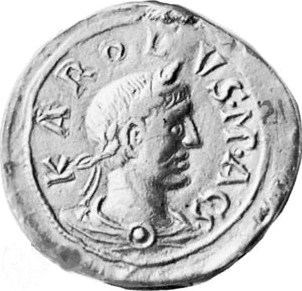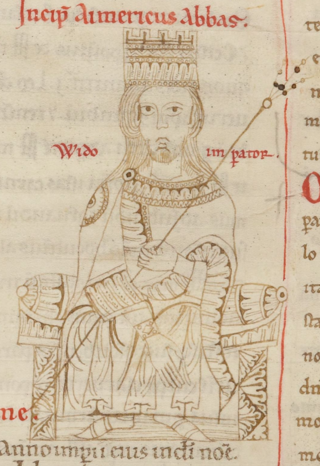
Arnulf of Carinthia was the duke of Carinthia who overthrew his uncle Emperor Charles the Fat to become the Carolingian king of East Francia from 887, the disputed king of Italy from 894 and the disputed emperor from February 22, 896, until his death at Regensburg, Bavaria.

Year 879 (DCCCLXXIX) was a common year starting on Thursday of the Julian calendar.

The Carolingian dynasty was a Frankish noble family named after Charlemagne, grandson of mayor Charles Martel and a descendant of the Arnulfing and Pippinid clans of the 7th century AD. The dynasty consolidated its power in the 8th century, eventually making the offices of mayor of the palace and dux et princeps Francorum hereditary, and becoming the de facto rulers of the Franks as the real powers behind the Merovingian throne. In 751 the Merovingian dynasty which had ruled the Germanic Franks was overthrown with the consent of the Papacy and the aristocracy, and Pepin the Short, son of Martel, was crowned King of the Franks. The Carolingian dynasty reached its peak in 800 with the crowning of Charlemagne as the first Emperor of the Romans in the West in over three centuries. His death in 814 began an extended period of fragmentation of the Carolingian Empire and decline that would eventually lead to the evolution of the Kingdom of France and the Holy Roman Empire.

Lotharingia was a medieval successor kingdom of the Carolingian Empire. It comprised present-day Lorraine (France), Luxembourg, Saarland (Germany), Netherlands, and the eastern half of Belgium, along with parts of today's North Rhine-Westphalia (Germany), Rhineland-Palatinate (Germany) and Nord (France). It was named after King Lothair II, who received this territory after the Kingdom of Middle Francia of his father, Lothair I, had been divided among his three sons in 855.

Charles III, also known as Charles the Fat, was the emperor of the Carolingian Empire from 881 to 888. A member of the Carolingian dynasty, Charles was the youngest son of Louis the German and Hemma, and a great-grandson of Charlemagne. He was the last Carolingian emperor of legitimate birth and the last to rule a united kingdom of the Franks.

King of Italy was the title given to the ruler of the Kingdom of Italy after the fall of the Western Roman Empire. The first to take the title was Odoacer, a barbarian military leader, in the late 5th century, followed by the Ostrogothic kings up to the mid-6th century. With the Frankish conquest of Italy in the 8th century, the Carolingians assumed the title, which was maintained by subsequent Holy Roman Emperors throughout the Middle Ages. The last Emperor to claim the title was Charles V in the 16th century. During this period, the holders of the title were crowned with the Iron Crown of Lombardy.
Richard, Duke of Burgundy (858–921), also known as Richard of Autun or Richard the Justiciar, was Count of Autun from 880 and the first Margrave and Duke of Burgundy. He eventually attained suzerainty over all the counties of Burgundy save Mâcon and by 890 he was referred to as dux (duke) and by 900 as marchio (margrave). By 918 he was being called dux Burgundionem or dux Burgundiae, which probably signified less the existence of a unified Burgundian dukedom than feudal suzerainty over a multiplicity of counties in a specific region.


Boso was a Frankish nobleman of the Bosonid family who was related to the Carolingian dynasty and who rose to become King of Lower Burgundy and Provence.

Guy III of Spoleto was the margrave of Camerino from 880 and then duke of Spoleto and Camerino from 883. He was crowned king of Italy in 889 and emperor in 891. He died in 894 while fighting for control of the Italian Peninsula.
Lambert I was the duke and margrave of Spoleto on two occasions, first from 859 to 871 and then from 876 to his death.
The Supponids were a Frankish noble family of prominence in the Carolingian regnum Italicum in the ninth century. They were descended from Suppo I, who appeared for the first time in 817 as a strong ally of the Emperor Louis the Pious. He and his descendants were on and off dukes of Spoleto, commonly in opposition to the Guideschi clan, another Frankish family powerful in central Italy.
The Bosonids were a dynasty of Carolingian era dukes, counts, bishops and knights descended from Boso the Elder. Eventually they married into the Carolingian dynasty and produced kings and an emperor of the Frankish Empire.
Suppo I was a Frankish nobleman who held lands in the Regnum Italicum in the early ninth century.
Winiges was the Duke of Spoleto from 789 to his death. He was probably a Lombard in the entourage of Charlemagne when he was sent in 788 to lead Hildeprand of Spoleto and Grimoald III of Benevento in cooperation with Frankish troops against a Byzantine invasion.
Bertila of Spoleto was the wife of Berengar I of Italy, and by marriage Queen consort of Italy and Holy Roman Empress.
Suppo II (835-885) was a member of the Supponid family. Engelberga, the wife of Louis II may have been his sister. He was Count of Parma, Asti, and Turin. Along with his cousin, Suppo III, he was the chief lay magnate in Italy during Louis's reign.
Louis the Younger, sometimes called Louis the Saxon or Louis III, was the second eldest of the three sons of Louis the German and Hemma. He succeeded his father as the King of Eastern Francia on 28 August 876 and his elder brother Carloman as King of Bavaria from 876 to 882. He died in 882 and was succeeded in all his territories, which encompassed most of East Francia, by his younger brother, Charles the Fat, already king of Italy and emperor.